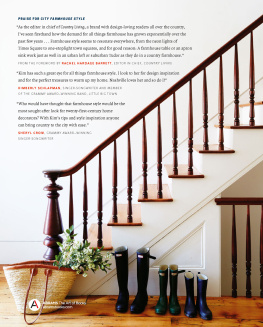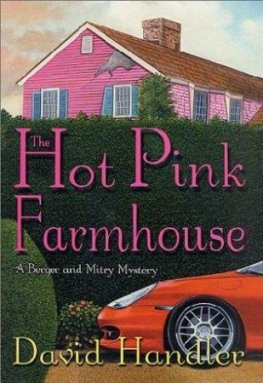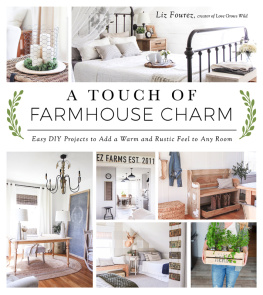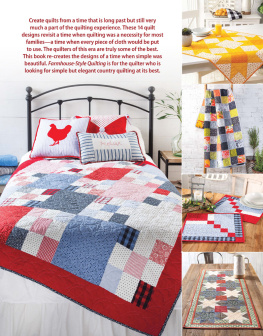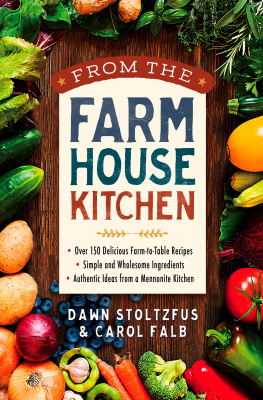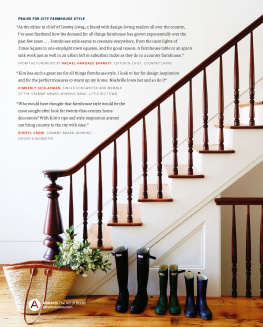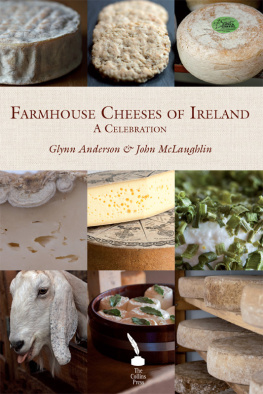
CONTENTS
FOREWORD BY
RACHEL HARDAGE BARRETT
CHAPTER 1
FARMHOUSE INSPIRATION
CHAPTER 2
THE UPTOWN CITY FARMHOUSE
CHAPTER 3
THE SUBURBAN CITY FARMHOUSE
CHAPTER 4
THE CREATIVE CITY FARMHOUSE
CHAPTER 5
PICKIN PLACES


Theres a simplicity to farmhouse staples that helps them play well with other design elements and aesthetics, whether your tastes veer toward the modern, traditional, or somewhere in between.
FOREWORD
Chalk it up to the ubiquitous farm-to-table trend, but it seems that anything branded with the word farmhouse is suddenly having a momentfrom simple white farmhouse kitchens to amber-hued farmhouse ales. Farmers, of course, were doing farm-to-table far before it became the hyphenate du jour on highfalutin city menus, and those same farming folk knew the merits of, say, a wide-bowl apron sink or easy-access open shelving well before those items became staples of designer portfolios and home dcor catalogs.
The real beauty of farmhouse styleunlike other more fleeting design trendsis that its rooted in roll-up-your-sleeves practicality. Farmhouses have been around for hundreds of years, after all, and they were designed to work hardto accommodate multigenerational families, feed a crowd, and, yes, handle a little dirt.
As the editor in chief of Country Living, a brand with design-loving readers all over the country, Ive seen firsthand how the demand for all things farmhouse has grown exponentially over the past few yearsand well beyond the county lines of honest-to-goodness farm towns. Farmhouse style seems to resonate everywhere, from the neon lights of Times Square to one-stoplight town squares, and for good reason: A farmhouse table or an apron sink work just as well in an urban loft or suburban Tudor as they do in a country farmhouse.
I also suspect farmhouse style has such widespread appeal because its inherently inviting. Its warm, welcoming, and, thanks to its adaptability, all-inclusive. At Country Living, we run across hundreds of objectively beautiful spaces every month, but our most important criteria when vetting homes is this: Does it make you want to fidget, or does it make you want to linger? If its the former, it falls into the no pile. A farmhouse-inspired home, if done right, certainly doesnt make you want to fidget. Nothing about farmhouse style is too precious, too sleek, too hard-lined, or too cold.
Its no surprise, then, that Kim Leggett, the brilliant design mind behind the lifestyle brand, blog, and boutique City Farmhouse (and author of this very book), has helped plant and grow the seeds of the farmhouse-style movement. Yes, she has an incredible eye for good design, but perhaps more important, she embodies the warm, open, friendly aesthetic of the farmhouse look. Our paths first crossed at a Country Living fair event several years ago, where, after I likely spent too much money in her perfectly curated booth, we started talking and realized that we both hail from the same small farming town nestled in the northwest corner of Tennessee. Maybe its because the muddy water of the Mississippi is thicker than blood, but Kim immediately felt like family. But heres the thing: I suspect she has that youre one of my people effect on pretty much everyone, and therein lies her personal sit-and-stay-awhile charm.
That sense of personal connection is another check mark in favor of farmhouse style, isnt it? At the risk of sounding a little crotchety old man, Ive found that modern-day social media connections simply cant compete with a sprawling front porch that fosters impromptu (in-person!) conversations with your neighbors or a long farmhouse table designed for sit-down Sunday suppers. Even other hallmarks of farmhouse stylefamily heirlooms, cleverly upcycled accentsare intended to connect us with the past. Creaky hardwood floors remind us of those who walked before us, as do the resourcefully repurposed items that decorate our planked walls and open shelves. (Now, if only someone could come up with a clever way to repurpose a Mason jar )
An aesthetic movement that not only values but also celebrates all things old, chipped, and weathered is pretty much destined to have longevity. Twenty years from now, you may question that chevron wallpaper or those ikat draperies, but you wont regret a cast-iron claw-foot tub or an heirloom-worthy iron bedframe. Farmhouse style is time-tested. It has staying power. You can bet the farm on it.
RACHEL HARDAGE BARRETT , editor in chief, Country Living

Farmhouse style is the design equivalent of sit and stay awhile.
INTRODUCTION
I was raised by my grandmother in a small Tennessee town of mostly long-standing farming families or blue-collar workers. The homes that made up our neighborhood were centered around a textile factorythe cotton mill, as it was known by the localsand were built to house the many laborers who made their living there. The architectural exteriors were designed as bungalows of sorts; all had a front porch and large picture windows. The dwellings were small, composed of only two bedrooms, but each had a space reserved for a dining room. We were close with our neighborsmeaning they were only a few feet away and friendly.
I grew up in the 1960s when retro design was all the rage. Pea greens, yellows, reds, and oranges showed up in everything from fabrics to wallpapers, carpeting to furnishings. Chrome dining sets ordered from the Sears, Roebuck and Company wish book appeared in every kitchen up and down the street, including our own. The popular color of the day was red, but my grandmother chose gray. There was a reason behind that: She was a style leader, not a follower. While our neighbors were painting their walls vibrant colors, she was painting hers white. And, while just across the street, mill worker Mrs. Cash, the local schoolteacher Mrs. Bell, and the seamstress Mrs. Waller were proudly showing off their new orange and green sofas, Minnie OlaBelle Harness (my grandmother) was upholstering hers in a tapestry of various shades of cream. Our seating didnt come from a catalog or the local furniture store. It was a 1930s tattered and torn Duncan Phyfestyle castoff found one Friday night at the local Peppermint Pond Auction. My bedroom suite was a hand-me-down from my grandmothers oldest daughter, my aunt Juanita. It was an antique, made of oak, and barely holding together. The golden surface was worn, and not in a pretty way, but Momma, as I called my grandmother, went to work making it look good as newin an old sort of way. She painted it white and distressed it so that its golden, worn surface peeked through. While our house looked nothing like the trendy homes along the street, our neighbors often remarked that it was the most beautiful.

Farmhouse style is born out of our love for the past and a desire to live a comfortable, more laid-back lifestyle.
Next page
